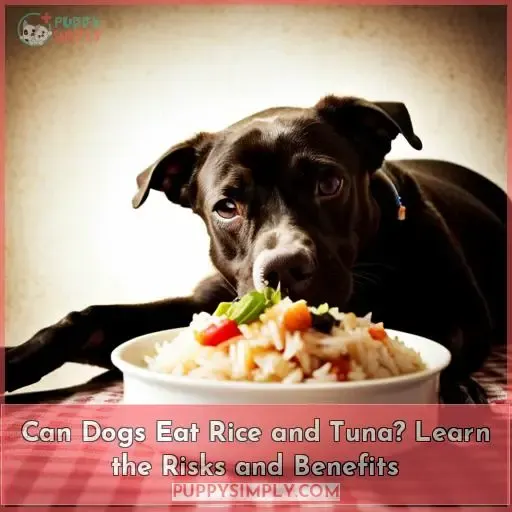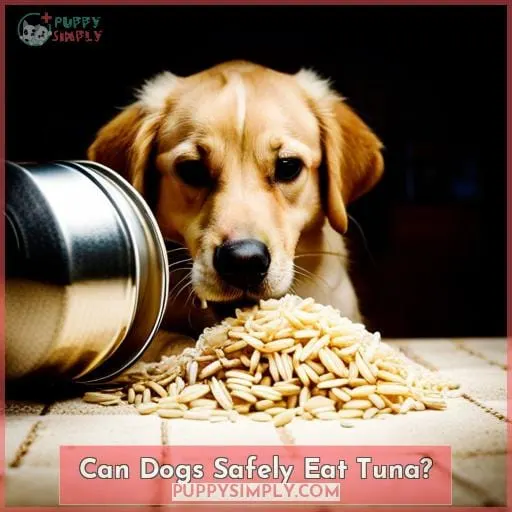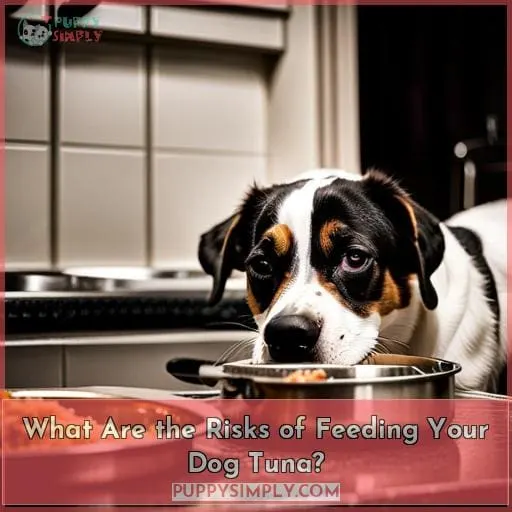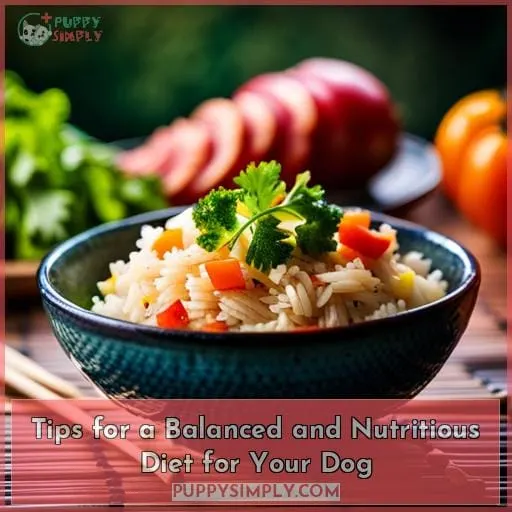This site is supported by our readers. We may earn a commission, at no cost to you, if you purchase through links.

Wondering if dogs can eat rice and tuna? You’re in luck! In this article, we’ll explore the safety of these two popular staples when it comes to feeding our four-legged friends.
From the risks associated with tuna consumption due to mercury levels, to potential benefits of salmon as an alternative source of protein – by the end, you will have all the information needed on whether or not dogs can eat rice and tuna safely.
So let’s dive in!
Table Of Contents
Key Takeaways
Dogs should avoid consuming tuna regularly due to high levels of mercury. Fresh salmon is a better option for protein and omega-3s due to its lower mercury levels. Rice can be a nutritious addition to a dog’s diet, but should not make up the majority of their meals.
Can Dogs Safely Eat Tuna?
You should limit your pet’s tuna consumption due to its high mercury levels and opt for other types of fish, such as salmon or whitefish, instead. Tuna contains heavy metals like mercury, which can cause serious health issues in dogs if not monitored closely.
Proper portion size is essential when feeding any type of fish to a dog, but especially tuna due to its higher metal content than others.
When shopping, look out for the Skipjack species of tuna as this is generally considered the safest option with lower levels of mercury compared to other varieties like bluefin or albacore. Avoid canned foods containing additional seasonings and spices that could make your pet ill.
Also, be cautious of products containing sunflower oil – although its good omega-6 fatty acids are beneficial, there may be too much salt present that isn’t healthy for dogs either.
Some wet cat food brands contain tuna, so always check labels before purchasing anything! Salmon is another great source of protein and omega-3 fatty acids that can provide all the nutritional benefits without risking exposure from dangerous heavy metals found in some types
What Are the Risks of Feeding Your Dog Tuna?
Making tuna a regular part of your pet’s diet can put them at risk for mercury poisoning, which can cause serious ailments like hair loss, blindness, and kidney damage. Excessive mercury in fish is the main reason why it should be avoided. Other types of fish have lower levels and are safer for dogs to eat.
It’s important to know the nutritional value of food and to follow feeding guidelines when choosing what type of dog food best suits your pup. If you’re concerned about high amounts of mercury in their diet, then safe alternatives such as salmon or whitefish are better options than tuna.
These also provide excellent sources of protein and omega-3 fatty acids that benefit pets’ wellbeing.
Pure Pet Food from Bristol University recommends limiting tuna consumption based on weight, so always check labels carefully before purchasing any product containing this ingredient. Too much tuna can lead to mercury poisoning in some cases, so try not to give more than occasionally depending on size/weight with no added salt content.
Can Dogs Eat Rice?
Rice can be a nutritious addition to your pet’s diet, but you should tread carefully like walking on eggshells. While rice is generally safe for dogs to eat, it shouldn’t make up the majority of their meals as it lacks certain nutrients essential for their wellbeing.
However, incorporating small amounts of rice into their diets can be beneficial in several ways.
Rice helps with digestion and weight control by adding fiber and bulk to your dog’s food, which promotes healthy bowel movements and keeps them fuller longer. It also serves as an excellent source of carbohydrates that provide energy needed for exercise activities.
Here is a table showcasing the nutritional content found in one cup (158g) cooked white rice:
| Nutrient | Amount |
|---|---|
| Calories | 205 kcal |
| Carbohydrates | 44 g |
| Protein | 4 g |
| Fat | 5 g |
If feeding fresh tuna alongside rice, canned skipjack species packed in spring water with no added salt content would be ideal due to lower mercury levels compared to other varieties such as bluefin or albacore that are high risk when consumed frequently.
What Are the Benefits of Feeding Your Dog Salmon?
Salmon is a great choice for your pup, providing them with essential proteins and omega-3 fatty acids that aid in growth and development. Feeding fish to your dog can be beneficial as they are a source of digestible protein, vitamins, minerals, and healthy fats like Omega 3s.
Salmon has the added benefit of containing Arctic Char oil, which helps reduce inflammation while promoting skin health. Switching up proteins from time to time keeps things interesting for your pet’s palate while still following nutrition guidelines for a balanced diet.
Here are some key points to consider when feeding salmon:
- High levels of Omega 3 fatty acids help keep joints supple.
- Rich in antioxidants & B vitamins promote energy production.
- Contains all 8 amino acid building blocks which support muscle repair.
- Low mercury levels make it safer than canned tuna varieties.
When considering adding fish into their diets, it’s important to try different types such as Salmon or Whitefish rather than sticking with just one type like Tuna.
Tips for a Balanced and Nutritious Diet for Your Dog
For a balanced and nutritious diet for your pup, try to include multiple sources of protein like salmon – it contains up to 20 times more omega-3 fatty acids than tuna does! A variety of fresh fish is the best choice as they contain lower mercury levels.
To ensure optimal health, you should also supplement their meals with healthy vegetables and fruits. For pet owners who are short on time or have allergies in the home, commercial dog food can be used, but make sure to find one that suits your pup’s dietary requirements.
When creating a meal plan for your furry friend, consider including some indoor activities such as brain puzzles or socializing with other pets while out on walks too! Exercise is an important factor when considering what kind of food intake works best for them.
If they’re getting lots of exercise, then there are different types of proteins that would work better than others depending on activity level.
Finally, remember not all commercially available dog foods are created equal, so do research into how nutritional values play into finding the right type that will benefit your pooch’s overall wellbeing.
Frequently Asked Questions (FAQs)
Is canned tuna safe for dogs to eat?
Yes, canned tuna can be safe for dogs to eat in moderation. It’s important to choose varieties with no added salt and that are low in mercury, such as Skipjack or Albacore.
How often should tuna be fed to dogs?
Tuna should only be fed to dogs occasionally and in moderation. Larger breeds may be able to eat it more often than smaller ones, but it’s best used as a special treat. Salmon is a better option for protein and omega-3s due to its lower mercury levels.
Is it safe to feed dogs cooked rice?
Yes, it is safe to feed your pup cooked rice. Rice can be a great source of energy and nutrition for dogs when served in moderation. It is full of vitamins and minerals that are essential for their health, just like humans.
What are the health benefits of feeding salmon to dogs?
Salmon is the golden ticket to your pup’s health. It is packed with protein, omega-3 fatty acids, vitamins, and antioxidants.
What foods should be avoided when feeding a balanced and nutritious diet to dogs?
When feeding a balanced and nutritious diet to dogs, it is important to avoid foods that are high in mercury, such as tuna and mackerel. Instead, opt for fresh fish with low levels of the toxin, like salmon or whitefish.
Additionally, it is best to avoid wet cat food due to its potential harm. To ensure balanced nutrition, provide a variety of proteins that are rich in vitamins and omega-3s while avoiding added salt and spices.
Conclusion
It’s important to remember that your pup’s health is a priority. Feeding your dog a balanced and nutritious diet, with fresh and short-lived fish, like salmon, is the key to keeping them healthy and happy.
You should limit tuna consumption, as it can contain high levels of mercury, which can lead to serious health issues.











